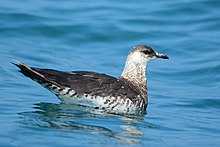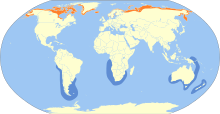Parasitic jaeger
| Parasitic jaeger | |
|---|---|

| |
| Scientific classification | |
| Domain: | Eukaryota |
| Kingdom: | Animalia |
| Phylum: | Chordata |
| Class: | Aves |
| Order: | Charadriiformes |
| Family: | Stercorariidae |
| Genus: | Stercorarius |
| Species: | S. parasiticus
|
| Binomial name | |
| Stercorarius parasiticus (Linnaeus,1758)
| |

| |
| Synonyms | |
|
Larus parasiticusLinnaeus, 1758 | |
Theparasitic jaeger(North America) orArctic skua(Europe) (Stercorarius parasiticus), is aseabirdin theskuafamily Stercorariidae. It is a migratory species that breeds in NorthernScandinavia,Scotland,Iceland,Greenland,Northern Canada,Alaska,andSiberiaand winters across the southern hemisphere.Kleptoparasitismis a major source of food for this species during migration and winter, and is where the name is derived from.
Taxonomy
[edit]The parasitic jaeger wasformally describedin 1758 by the Swedish naturalistCarl Linnaeusin thetenth editionof hisSystema Naturaeunder thebinomial nameLarus parasiticus.[2]Linnaeus specified thetype localityas "within the Tropic of Cancer of Europe, America and Asia" but this is now restricted to the Swedish coastline.[3]The parasitic jaeger is now placed with the six other skuas in the genusStercorariusthat was introduced in 1760 by the French zoologistMathurin Jacques Brisson.The species is considered to bemonotypic:nosubspeciesare recognised.[4]The genus nameStercorariusisLatinand means "of dung"; the food disgorged by other birds when pursued by skuas was once thought to be excrement. The specificparasiticusis from Latin and means "parasitic".[5]The word "jaeger" is theGermanwordJäger,meaning "hunter".[6]The English "skua" comes from theFaroesenameskúgvur[ˈskɪkvʊər]for thegreat skua,with the island ofSkúvoyknown for its colony of that bird. The general Faroese term for skuas iskjógvi[ˈtʃɛkvə].[7]
Description
[edit]
Identification is complicated by similarities tolong-tailed jaegerandpomarine jaeger,and the existence of three colourmorphs.Small for a skua, the parasitic jaeger measures 41–48 cm (16–19 in) in length, 107–125 cm (42–49 in) in wingspan and weighs 300–650 g (11 oz – 1 lb 7 oz).[8][9]The tail streamer of the breeding adult accounts for about 7 cm (3 in) of their length. Light-morph adults have a brown back, mainly white underparts and dark primary wing feathers with a white "flash". The head and neck are yellowish-white with a black cap and there is a pointed central tail projection. Dark-morph adults are dark brown, and intermediate-phase birds are dark with somewhat paler underparts, head and neck. All morphs have the white wing flash.

Identification of juveniles is even more problematic, and it is difficult to separate parasitic jaegers from long-tailed jaegers. Parasitic jaegers are bulkier, shorter-winged, and less tern-like than long-tailed jaegers. They are usually warmer toned, with browner shades, rather than grey. However, they show the same wide range of plumage variation. The flight is morefalcon-like. The parasitic jaeger is the most common of the three jaeger species seen from shore.
The typical call of these birds is a nasal mewing sound, repeated a few times in display. Their alarm call is a shorter sound.
Distribution and habitat
[edit]This species breeds in the north ofEurasiaand North America, with significant populations as far south as northernScotland,inShetlandandOrkney,theOuter Hebrides,Sutherland,Caithness,and some islands inArgyll.Birds in North America breed inAlaska,Yukon,Northwest Territories,Nunavut,theHudson Baycoast, and parts ofNorthern QuebecandNunatsiavut.[10]
The parasitic jaeger is amigrant,wintering at sea in the tropics and southern oceans. While much of the migration is over sea, overland spring migration occurs in theCanning River Valley,Alaska,and overland fall migration occurs from northernRussiato thePersian Gulfamong Eurasian populations, and over theGreat Lakes(particularlyLake Ontario) among American populations.[11]
Behavior
[edit]Breeding
[edit]
Nesting occurs on drytundra,higherfells,and islands.Clutchesconsist of up to four olive-brown eggs. Jaegers are usually silent except for mewing and wailing notes while on the breeding grounds. Like other skuas, it will fly at the head of a human or fox approaching its nest.
Feeding
[edit]This bird will feed on rodents, insects, eggs, chicks and small birds in the breeding season, but the majority of its diet (especially in winter and on migration) is made up of food that it acquires by robbing otherbirds(primarilygullsandterns) of their catches in an act calledkleptoparasitism.
Conservation status
[edit]In 2018,Stercorarius parasiticuswas regionally uplisted to Endangered in Iceland, from Least Concern in 2000, after their numbers declined drastically in the early 2000s.[12]It is globally listed as Least Concern.
References
[edit]- ^abBirdLife International (2018)."Stercorarius parasiticus".IUCN Red List of Threatened Species.2018:e.T22694245A132535550.doi:10.2305/IUCN.UK.2018-2.RLTS.T22694245A132535550.en.Retrieved7 September2022.
- ^Linnaeus, Carl(1758).Systema Naturae per regna tria naturae, secundum classes, ordines, genera, species, cum characteribus, differentiis, synonymis, locis(in Latin). Vol. 1 (10th ed.). Holmiae (Stockholm): Laurentii Salvii. pp. 136–137.
- ^Peters, James Lee,ed. (1934).Check-List of Birds of the World.Vol. 2. Cambridge, Massachusetts: Harvard University Press. p. 311-312.
- ^Gill, Frank;Donsker, David;Rasmussen, Pamela,eds. (December 2023)."Noddies, gulls, terns, auks".IOC World Bird List Version 14.1.International Ornithologists' Union.Retrieved21 July2024.
- ^Jobling, James A (2010).The Helm Dictionary of Scientific Bird Names.London: Christopher Helm. pp.292,365.ISBN978-1-4081-2501-4.
- ^"Jaeger".Oxford English Dictionary(Online ed.).Oxford University Press.(Subscription orparticipating institution membershiprequired.)
- ^"Skua".Oxford English Dictionary(Online ed.).Oxford University Press.(Subscription orparticipating institution membershiprequired.)
- ^"Parasitic jaeger".2011. Archived fromthe originalon 2011-11-06.Retrieved2011-10-20.
- ^Dunning, John B. Jr., ed. (1992).CRC Handbook of Avian Body Masses.CRC Press.ISBN978-0-8493-4258-5.
- ^Wiley, R.H.; Lee, D.S. (2020). Billerman, S.M. (ed.)."Parasitic Jaeger (Stercorarius parasiticus), version 1.0 ".Birds of the World.Ithaca, NY, USA: Cornell Lab of Ornithology.Retrieved20 July2024.
- ^Sherony, Dominic F. (1999)."The Fall Migration of Jaegers on Lake Ontario".Journal of Field Ornithology.70(1): 33–41.JSTOR4514379– via JSTOR.
- ^https:// ni.is/node/27109Kristinn Haukur Skarphéðinsson, "Kjói (Stercorarius parasiticus), "Icelandic Institute of Natural History, last updated October 2018.
External links
[edit]- Arctic skua -Species text in The Atlas of Southern African Birds
- Arctic skua information and photos at the Handa Island Skua Project
- RSPBBirds by Name: Arctic skua
- "Arctic skua media".Internet Bird Collection.
- Parasitic jaeger photo galleryat VIREO (Drexel University)
- Interactive range map ofStercorarius parasiticusatIUCN Red List maps
- Audio recordings of Parasitic jaegeronXeno-canto.


